What'sNEW Jan - Mar 2022
These results support the capability of molecular replicators to spontaneously develop complexity through Darwinian evolution, a critical step for the emergence of life. Three biochemists at the University of Tokyo claim it's a breakthrough in RNA World research. RNAs with different lengths (~ 220 nt, ~1100 nt, and ~500 nt) were seen to replicate and vary in content after 240 rounds of serial transfer experiments. The development of a lasting "multiple replicator network" was new.
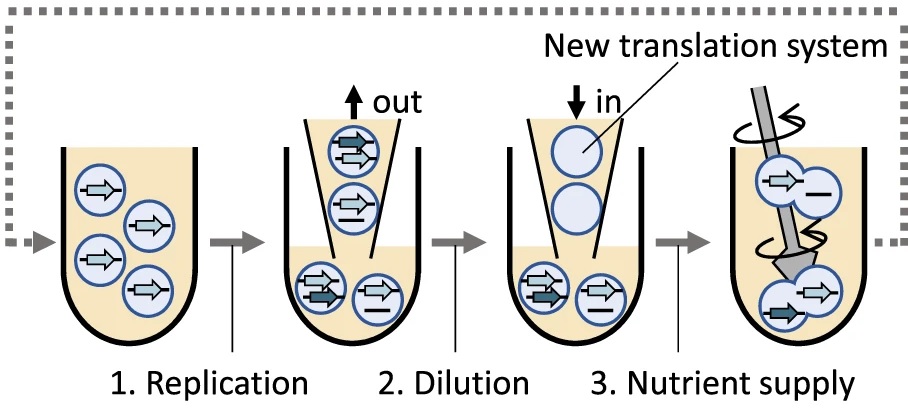
The research was painstaking and thorough, but let's be realistic. It began with biological RNA replicase and long-enough, properly-sequenced strands of RNA. Even with only biological RNA, this beginning is extremely unlikely, as shown in a strictly mathematical analysis two years ago. Of course, any natural "prebiotic soup" would contain ruinous other ingredients. And all of this ignores the software issue: Where does genetic programming come from?
The RNA World and its variants seek to explain a phenomenon that has never been observed. What we do observe is that life always comes from life. Origin-of-Life research looks like medieval alchemy to me.
 "Evolutionary transition from a single RNA replicator to a multiple replicator network" by R.Mizuuchi, T. Furubayashi, and N. Ichihashi, doi:10.1038/s41467-022-29113-x, Nature Communications, 18 Mar 2022. "Evolutionary transition from a single RNA replicator to a multiple replicator network" by R.Mizuuchi, T. Furubayashi, and N. Ichihashi, doi:10.1038/s41467-022-29113-x, Nature Communications, 18 Mar 2022.
 "New Insight Into Possible Origins of Life: For the First Time Researchers Create an RNA Molecule That Replicates", SciTech Daily, 19 Mar 2022. "New Insight Into Possible Origins of Life: For the First Time Researchers Create an RNA Molecule That Replicates", SciTech Daily, 19 Mar 2022.
 Thanks, Stan Franklin. Thanks, Stan Franklin.
 21 Apr 2020: An astronomer at The University of Tokyo calculates the unlikelihood. 21 Apr 2020: An astronomer at The University of Tokyo calculates the unlikelihood.
 Alchemy? Origin-of-Life research is not sceptical enough. Alchemy? Origin-of-Life research is not sceptical enough.
 The RNA World and Other Origin-of-Life Theories has more. The RNA World and Other Origin-of-Life Theories has more.
In cosmic ancestry, successful advanced life on any planet depends on universal Gaian processes. These are provided by extant genetic programs installed following horizontal gene transfer. This unorthodox, layered conjecture gains support from research by a trio of planetary scientists at MIT.
 "Oxidative metabolisms catalyzed Earth's oxygenation" by H. Shang, D.H. Rothman, and G.P. Fournier, doi:10.1038/s41467-022-28996-0, Nature, 14 Mar 2022. "Oxidative metabolisms catalyzed Earth's oxygenation" by H. Shang, D.H. Rothman, and G.P. Fournier, doi:10.1038/s41467-022-28996-0, Nature, 14 Mar 2022.
Our analyses show that one major group of [marine oxidative metabolising bacteria] likely acquired [the needed enzyme] around the time of the GOE via a horizontal gene transfer event....
 Gaia has our introduction to this philosophy of natural environmental management. Gaia has our introduction to this philosophy of natural environmental management.
...the theory of cometary panspermia continues, after 35 years of rigorous debate, to provide a powerful unifying theory for a collection of otherwise unconnected and disparate scientific data from a range of disciplines.
 "Evidence of Panspermia: From Astronomy to Meteorites," by Jamie Hamilton Wallis [PDF], PhD thesis, Cardiff University, 2014. "Evidence of Panspermia: From Astronomy to Meteorites," by Jamie Hamilton Wallis [PDF], PhD thesis, Cardiff University, 2014.
 C. Thomas Caskey (1938–2022) demonstrated the universality of life's code, J Witkowski, Nature, 11 Mar 2022. C. Thomas Caskey (1938–2022) demonstrated the universality of life's code, J Witkowski, Nature, 11 Mar 2022.
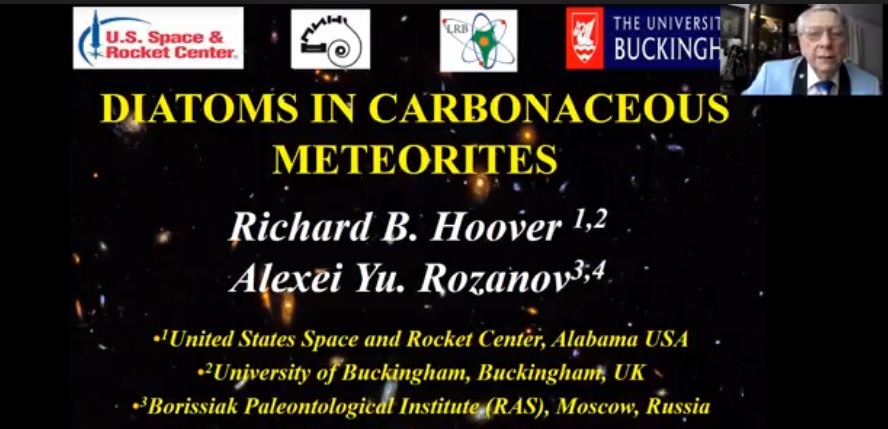 Astrobiologist Richard Hoover discusses microfossils in meteorites in a short video. With lots of data, he makes the case that fossils seen in carbonaceous meteorites like Orgueil are extraterrestrial. He also discusses Polonnaruwa, a meteorite unlike any other known ones. It, too, contains fossilized diatoms.
Astrobiologist Richard Hoover discusses microfossils in meteorites in a short video. With lots of data, he makes the case that fossils seen in carbonaceous meteorites like Orgueil are extraterrestrial. He also discusses Polonnaruwa, a meteorite unlike any other known ones. It, too, contains fossilized diatoms.
 Diatoms in Carbonaceous Meteorites, 14-min. video, 2021. Diatoms in Carbonaceous Meteorites, 14-min. video, 2021.
 Collected articles includes ...Atlas of Microfossils by Hoover et al. Collected articles includes ...Atlas of Microfossils by Hoover et al.
 11 Jan 2013: our first notice about Polonnaruwa, and updates. 11 Jan 2013: our first notice about Polonnaruwa, and updates.
| 08 Mar 2022 |
What'sNEW about HGT  | |
|
What causes a latent virus to begin to proliferate? A sure answer to this question would be beneficial in medicine, but the question pertains to all of life. For viruses affecting prokaryotes, we learn that E. coli can release a chemical called colibactin that awakens dormant viruses inside nearby bacteria. What stimulates this release? Something environmental? Could the release be part of "adaptive mutation" among bacteria? It's just a guess, but we know that adaptive mutation is real, and that viral genes can transform whole populations, even eukaryotic ones.
 The bacterial toxin colibactin triggers prophage induction, by Justin E. Silpe et al., Nature, 23 Feb 2022. The bacterial toxin colibactin triggers prophage induction, by Justin E. Silpe et al., Nature, 23 Feb 2022.
 Bacteria Set Off Viral "Bombs" Inside Neighbors, by Natalia Mesa, The Scientist, 07 Mar 2022. Bacteria Set Off Viral "Bombs" Inside Neighbors, by Natalia Mesa, The Scientist, 07 Mar 2022.
 Viruses... has our primer about the lytic and lysogenic cycles in viruses. Viruses... has our primer about the lytic and lysogenic cycles in viruses.
Bacterial genes transferred to eukaryotic microbiomes can bring macroevolutionary advances.
 Diverse events have transferred genes for edible seaweed digestion from marine to human gut bacteria, by Jianchao Ma, Shuanghua Wang et al., doi:10.1016/j.chom.2022.02.001, Molecular Plant, 01 Mar 2022. ...our data point to a far greater scope of historical HGT than we currently realize. Diverse events have transferred genes for edible seaweed digestion from marine to human gut bacteria, by Jianchao Ma, Shuanghua Wang et al., doi:10.1016/j.chom.2022.02.001, Molecular Plant, 01 Mar 2022. ...our data point to a far greater scope of historical HGT than we currently realize.
 Genes stolen from marine organisms may help us digest seaweed, by Elizabeth Pennisi, Science, 01 Mar 2022. Genes stolen from marine organisms may help us digest seaweed, by Elizabeth Pennisi, Science, 01 Mar 2022.
 Thanks, Imma Perfetto, Cosmos Magazine, 02 Mar. Thanks, Imma Perfetto, Cosmos Magazine, 02 Mar.
 Viruses and Other Gene Transfer Mechanisms links to thousands of examples of HGT. Viruses and Other Gene Transfer Mechanisms links to thousands of examples of HGT.
| 01 Mar 2022 |
What'sNEW about HGT
 | |
|
...a horizontal gene transfer from bacteria ...created a new epigenetic system in animals.... So say molecular biologists from the Marine Biological Laboratory in an open-access article. The transfer provided a new regulatory system to eukaryotic life. Co-first author Irina Yushenova says, It's almost unbelievable. Conventional darwinists are frequently surprised, because they believe evolution makes inventions by accident. But in cosmic ancestry, complex "new" genetic programs are already available, and robust software management can enable species to acquire them by HGT, install, and test them for suitablilty. Today's evidence supports this view.
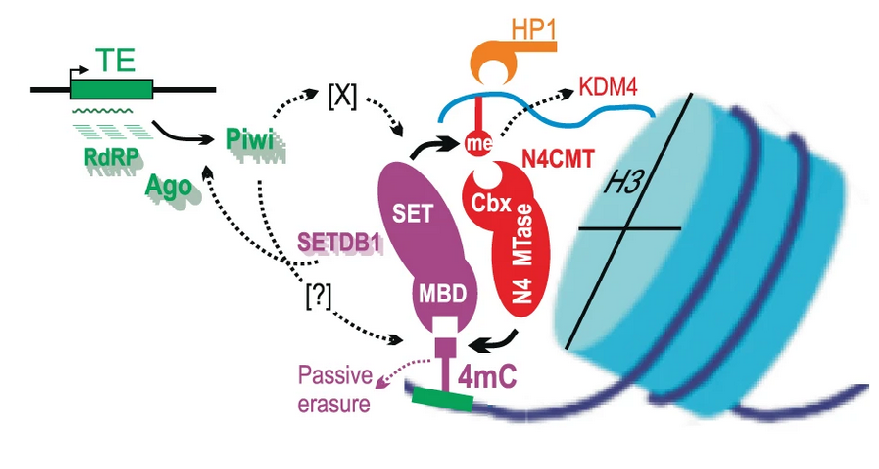
 Bacterial N4-methylcytosine as an epigenetic mark in eukaryotic DNA, by Fernando Rodriguez, Irina A. Yushenova et al., doi:10.1038/s41467-022-28471-w, Nature Communications, 28 Feb 2022.
Our work demonstrates how a horizontally transferred gene can become part of a complex regulatory system maintained by selection over tens of millions of years of evolution. Bacterial N4-methylcytosine as an epigenetic mark in eukaryotic DNA, by Fernando Rodriguez, Irina A. Yushenova et al., doi:10.1038/s41467-022-28471-w, Nature Communications, 28 Feb 2022.
Our work demonstrates how a horizontally transferred gene can become part of a complex regulatory system maintained by selection over tens of millions of years of evolution.
 ...New DNA Modification System in Animals, Captured from Bacteria, by Diana Kenney, Marine Biological Laboratory +EurekAlert, 28 Feb 2022. It's like magic. ...New DNA Modification System in Animals, Captured from Bacteria, by Diana Kenney, Marine Biological Laboratory +EurekAlert, 28 Feb 2022. It's like magic.
 Viruses and Other Gene Transfer Mechanisms links to thousands of examples of HGT. Viruses and Other Gene Transfer Mechanisms links to thousands of examples of HGT.
 Robust Software Management in Genomes begins to outline the topic. Robust Software Management in Genomes begins to outline the topic.
 A computer model of a minimal cell contains 493 genes.
A computer model of a minimal cell contains 493 genes.
 Essential metabolism for a minimal cell, by Marian Breuer et al., eLife, 18 Jan 2022. Essential metabolism for a minimal cell, by Marian Breuer et al., eLife, 18 Jan 2022.
 Most Complete Simulation of a Cell Probes Life's Hidden Rules, by Yasemin Saplakoglu, Quanta Magazine, 24 Feb 2022. Most Complete Simulation of a Cell Probes Life's Hidden Rules, by Yasemin Saplakoglu, Quanta Magazine, 24 Feb 2022.
 What Is Life? The simplest form of life is not simple. What Is Life? The simplest form of life is not simple.
| 24 Feb 2022 |
What'sNEW about HGT
 | |
|
Transposable Elements' (TEs) outsized potential both to affect expression and to alter the genetic code make them important players in evolution.... They move within geneomes and transfer readily across species. They are found in almost every form of life, in proportions that vary widely. A new review article includes history and many examples.
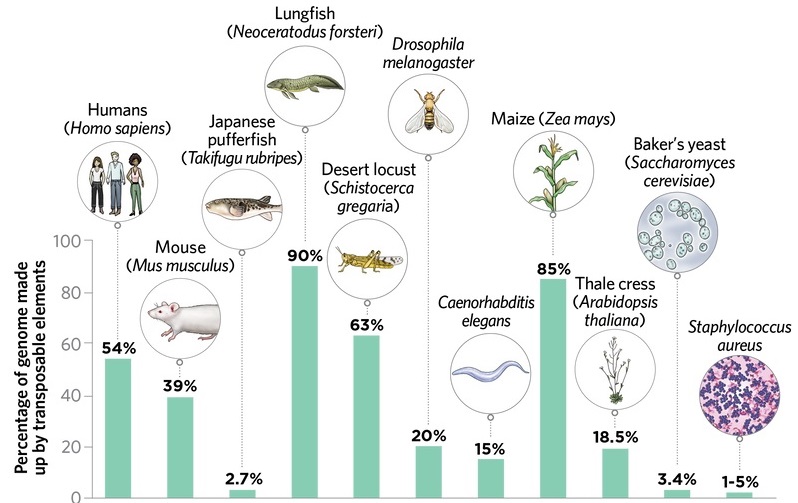
 Adapting with a Little Help from Jumping Genes by Christie Wilcox, The Scientist, 17 Jan 2022. Adapting with a Little Help from Jumping Genes by Christie Wilcox, The Scientist, 17 Jan 2022.
 Viruses and Other Gene Transfer Mechanisms has a primer and updates about HGT. Viruses and Other Gene Transfer Mechanisms has a primer and updates about HGT.
 Huntsville Mineral and Gem Society features Richard B. Hoover, 22 Feb 2022. Huntsville Mineral and Gem Society features Richard B. Hoover, 22 Feb 2022.
 Collected articles by Richard Hoover Collected articles by Richard Hoover
 A Mysterious Desert Bacterium Has Evolved Its Own, Unique Ability to Photosynthesize, by Tessa Koumoundouros, ScienceAlert, 20 Feb 2022.
Sometime during the bacterium's history, it stole a whole suite of photosynthesis-related genes from a more ancient proteobacterium.... A Mysterious Desert Bacterium Has Evolved Its Own, Unique Ability to Photosynthesize, by Tessa Koumoundouros, ScienceAlert, 20 Feb 2022.
Sometime during the bacterium's history, it stole a whole suite of photosynthesis-related genes from a more ancient proteobacterium....
 2.4-Å structure of the double-ring Gemmatimonas phototrophica photosystem, by Pu Qian et al., Science Advances, 16 Feb 2022. 2.4-Å structure of the double-ring Gemmatimonas phototrophica photosystem, by Pu Qian et al., Science Advances, 16 Feb 2022.
 Viruses and Other Gene Transfer Mechanisms has more about HGT in all domains. Viruses and Other Gene Transfer Mechanisms has more about HGT in all domains.
 A Billion Years Before Sex, Ancient Cells Were Equipped for It, Jake Buehler, Quanta Magazine, 16 Feb 2022. A Billion Years Before Sex, Ancient Cells Were Equipped for It, Jake Buehler, Quanta Magazine, 16 Feb 2022.
 Archaeal origins of gamete fusion, by David Moi et al., doi:10.1101/2021.10.13.464100, bioRxiv, 13 Oct 2021. Archaeal origins of gamete fusion, by David Moi et al., doi:10.1101/2021.10.13.464100, bioRxiv, 13 Oct 2021.
 Metazoan Genes Older Than Metazoa? and Metazoan Genes Older Than Metazoa? and
 Genes Older Than Earth? have more. Genes Older Than Earth? have more.
...the red planet was wetter for 500 million years longer than previously thought....
 Circumpolar ocean stability on Mars 3 Gy ago, by Frédéric Schmidt et al., PNAS, 25 Jan 2022. Circumpolar ocean stability on Mars 3 Gy ago, by Frédéric Schmidt et al., PNAS, 25 Jan 2022.
 Mars May Have Been Habitable Longer Than Thought, by Beth Johnson, SETI, 15 Feb 2022. Mars May Have Been Habitable Longer Than Thought, by Beth Johnson, SETI, 15 Feb 2022.
 Sea Lilies on Ancient Mars? Why not?! Sea Lilies on Ancient Mars? Why not?!
 Life on Mars! has more. Life on Mars! has more.
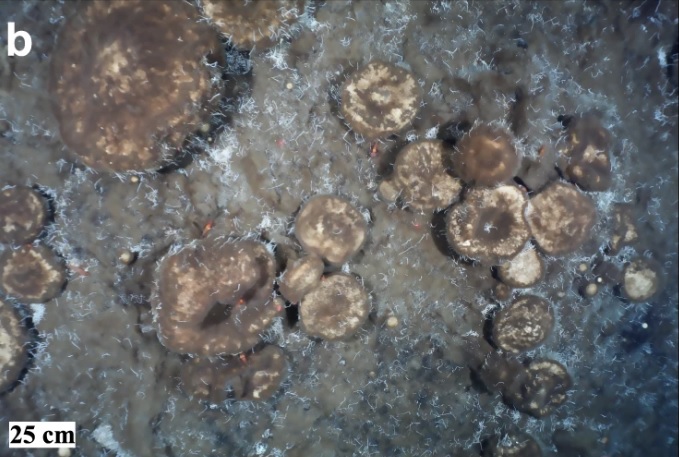 Sponges flourish deep under the ice-covered Arctic Ocean. Why not also on Europa or Enceladus?
Sponges flourish deep under the ice-covered Arctic Ocean. Why not also on Europa or Enceladus?
 Giant sponge grounds of Central Arctic seamounts are associated with extinct seep life, by T. M. Morganti et al., doi:10.1038/s41467-022-28129-7, Nature Communications, 08 Feb 2022. Giant sponge grounds of Central Arctic seamounts are associated with extinct seep life, by T. M. Morganti et al., doi:10.1038/s41467-022-28129-7, Nature Communications, 08 Feb 2022.
 Massive Sponge Gardens Discovered on the Peaks of Extinct Underwater Volcanoes in the Arctic Deep Sea, by Alfred Wegener Institute, SciTechDaily, 08 Feb 2022. Massive Sponge Gardens Discovered on the Peaks of Extinct Underwater Volcanoes in the Arctic Deep Sea, by Alfred Wegener Institute, SciTechDaily, 08 Feb 2022.
 Thanks, Ted Steele. Thanks, Ted Steele.
 Life on Europa, Other Moons, Other Planets? has related links. Life on Europa, Other Moons, Other Planets? has related links.
 The Great Floods of Mars by Juan Siliezar, Harvard Gazette, 31 Jan 2022. The Great Floods of Mars by Juan Siliezar, Harvard Gazette, 31 Jan 2022.
 Life on Mars! has lots about water or oceans there. Life on Mars! has lots about water or oceans there.
How does life evolve? This question has been a primary focus of this website from the beginning. It is now clear that horizontal gene transfer (HGT) can deliver the new genetic programs that underlie macroevolutionary advances. Among prokaryotes, other sources for new genes are not seen, and the paradigm shift to HGT looks complete. Eukaryotes appear to be headed for the same shift.
Of course point mutations in genes are ongoing, and microevolution also occurs. In fact, the rate of point mutations can be increased by various stresses; "adaptive mutation" has been witnessed for decades. And with "directed mutation," the nucleotide substitutions can even be concentrated in specific locations. How this is controlled is not clear.
Meanwhile, remember, 98.5% of the human genome is "non-coding," not used to make proteins or rRNA or tRNA. Some of this larger fraction is regulatory, controlling the activity of other genes with cascading logic. If the coding genes are present, regulatory genes may turn them off or on to complete a macroevolutionary step. And the regulatory ones can themselves be deactivated or reactivated by point mutations.
Fifteen years ago, molecular biologists at the University of California, Santa Cruz, studied the mutational history of human genes. They began by asking which parts of the human genome shared with chimps had changed most rapidly. Indeed there are some obvious "human accelerated regions" (HARs). More than two hundred ... appear to have been very stable for an extended evolutionary period ...before being radically reworked during the last ∼5 million y of human evolution. Apparently, human regulatory genes were changing fastest of all.

How does life evolve? Although random point mutations can't be expected to compose new genetic programs, directed mutations in regulatory sequences may plausibly find improvements if the installed, viable choices can be located. Fast evolving human regulatory genes support this suggestion.
 Forces Shaping the Fastest Evolving Regions in the Human Genome by Katherine S Pollard et al., doi:10.1371/journal.pgen.0020168, PLoS Genet., 13 Oct 2006. Forces Shaping the Fastest Evolving Regions in the Human Genome by Katherine S Pollard et al., doi:10.1371/journal.pgen.0020168, PLoS Genet., 13 Oct 2006.
 Thanks, James Powers. Thanks, James Powers.
 Robust Software Management... (incomplete) mentions many phemonena unexplained by neo-darwinism. Robust Software Management... (incomplete) mentions many phemonena unexplained by neo-darwinism.
 13 Feb 2022: ...some "birth defects" might actually be the right choice on another planet? 13 Feb 2022: ...some "birth defects" might actually be the right choice on another planet?
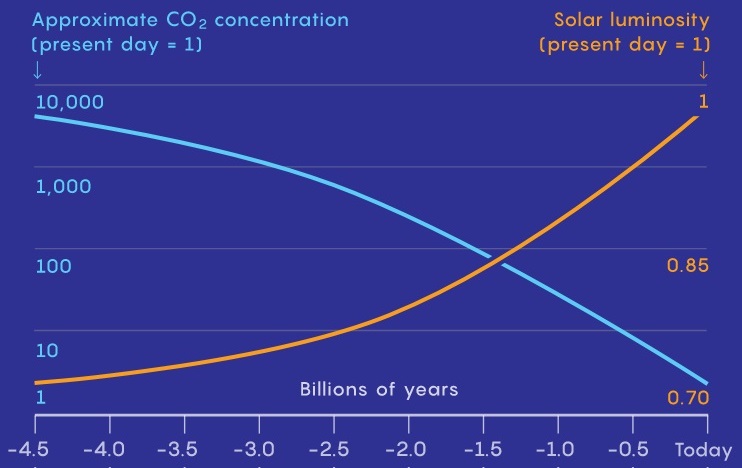
 A Solution to the Faint-Sun Paradox Reveals a Narrow Window for Life by Jonathan O'Callaghan, Quanta Magazine, 27 Jan 2022.
Back when the sun was 30% dimmer, Earth should have frozen solid. Yet water flowed and life blossomed. (The article doesn't mention heat from inside the Earth.) A Solution to the Faint-Sun Paradox Reveals a Narrow Window for Life by Jonathan O'Callaghan, Quanta Magazine, 27 Jan 2022.
Back when the sun was 30% dimmer, Earth should have frozen solid. Yet water flowed and life blossomed. (The article doesn't mention heat from inside the Earth.)
 Gaia and Gaia and
 Life Before 3850 Mya? have background and updates. Life Before 3850 Mya? have background and updates.
Challenges associated with studying terrestrial life in deep space are the subject of an engineering-oriented study from the University of California, Santa Barbara. Stephen Lantin et al. suggest that current laser technology would enable us to send small biology samples into space at relativistic speed, like .25c. This would allow us, within decades, to see how interstellar space affects life as we know it. It sounds a bit like directed panspermia, but directed only away. The engineers plan to steer out of the ecliptic plane, and promise not to infect any other planets. Very wide-ranging and worth a look.
 Interstellar space biology via Project Starlight by Stephen Lantin et al., Acta Astronautica, Jan 2022. Interstellar space biology via Project Starlight by Stephen Lantin et al., Acta Astronautica, Jan 2022.
 Sending life to the stars by Sonia Fernandez, UCSB, +PhysOrg, 06 Jan 2022. Sending life to the stars by Sonia Fernandez, UCSB, +PhysOrg, 06 Jan 2022.
 Thanks, Zach Baker. Thanks, Zach Baker.
 Going Interstellar with a Laser-Powered Rocket by Paul Gilster, Centauri Dreams, 15 Feb 2022. Going Interstellar with a Laser-Powered Rocket by Paul Gilster, Centauri Dreams, 15 Feb 2022.
| 25 Jan 2022 |
What'sNEW about HGT | |
|
...many of the systems found in bacterial genomes ...are actually encoded in MGEs [mobile genetic elements].
 Prokaryotic evolution uses horizontal gene transfer (HGT) to acquire new genes, including defense cassettes traded by various MGEs. The transfers often bring only some of what's needed, plus some that's useless or worse.
Pruning is required. A review from the Pasteur Institute has insights and questions.
Prokaryotic evolution uses horizontal gene transfer (HGT) to acquire new genes, including defense cassettes traded by various MGEs. The transfers often bring only some of what's needed, plus some that's useless or worse.
Pruning is required. A review from the Pasteur Institute has insights and questions.
 Microbial defenses against mobile genetic elements and viruses: Who defends whom from what? by Eduardo P. C. Rocha and David Bikard, doi:10.1371/journal.pbio.3001514, PLoS Biol, 13 Jan 2022. Microbial defenses against mobile genetic elements and viruses: Who defends whom from what? by Eduardo P. C. Rocha and David Bikard, doi:10.1371/journal.pbio.3001514, PLoS Biol, 13 Jan 2022.
 10 Mar 2021: New hub for HGT among prokaryotes, with links. 10 Mar 2021: New hub for HGT among prokaryotes, with links.
 Viruses... has a primer and many examples of HGT. Viruses... has a primer and many examples of HGT.
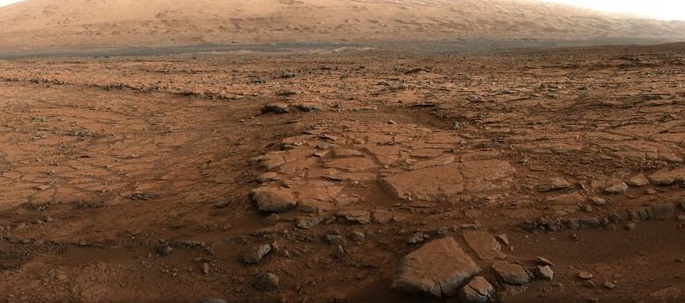 ...carbon trapped in ...rocks probed by the rover is dramatically enriched in light isotopes of carbon. On Earth, the signal would be seen as strong evidence for ancient microbial life.
...carbon trapped in ...rocks probed by the rover is dramatically enriched in light isotopes of carbon. On Earth, the signal would be seen as strong evidence for ancient microbial life.
 Depleted carbon isotope compositions observed at Gale crater, Mars by Christopher H. House et al., PNAS, 25 Jan 2022. Depleted carbon isotope compositions observed at Gale crater, Mars by Christopher H. House et al., PNAS, 25 Jan 2022.
 Mars rover detects carbon signature that hints at past life source by Paul Voosen, Science, 17 Jan 2022. Mars rover detects carbon signature that hints at past life source by Paul Voosen, Science, 17 Jan 2022.
 Life on Mars! has news and updates since 1996. Life on Mars! has news and updates since 1996.
Mutation is not random. A new study by European and US biologists uses a common flowering weed to confirm this. The confirmation was not simple, because most point mutations are promptly reversed by DNA repair mechanisms, or are soon eliminated by natural selection.
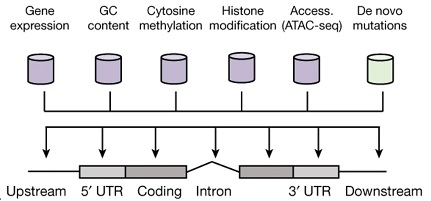
"Adaptive mutation" and even "directed mutation" have been noticed for decades, but this study goes deeper. It concludes that "epigenome-associated mutation bias" protects much of the genome from harmful mutations. This would allow only appropriate genetic programs to be explored and optimized for changing circumstances. Thus, point mutations can allow microevolution while essential programs are safe.
 Mutation bias reflects natural selection in Arabidopsis thaliana by Monroe, J.G., Srikant, T., Carbonell-Bejerano, P. et al., doi:10.1038/s41586-021-04269-6, Nature, 12 Jan 2022. Mutation bias reflects natural selection in Arabidopsis thaliana by Monroe, J.G., Srikant, T., Carbonell-Bejerano, P. et al., doi:10.1038/s41586-021-04269-6, Nature, 12 Jan 2022.
 Important genomic regions mutate less often than do other regions by Jianzhi Zhang, Nature, 12 Jan 2022. Important genomic regions mutate less often than do other regions by Jianzhi Zhang, Nature, 12 Jan 2022.
 Essential Genes Protected from Mutations by Dan Robitzski, The Scientist, 25 Jan 2022. Essential Genes Protected from Mutations by Dan Robitzski, The Scientist, 25 Jan 2022.
 How is it Possible? includes early mention of adaptive and directed mutation with updates. How is it Possible? includes early mention of adaptive and directed mutation with updates.
 Macroevolutionary Progress... and Macroevolutionary Progress... and  Does Microevolution Explain... have related discussion. Does Microevolution Explain... have related discussion.
 30 Jan 2022: Directed mutation in human regulatory genes! 30 Jan 2022: Directed mutation in human regulatory genes!
Fred Hoyle once told me, "All scientific truth goes through three stages:
1) That's the craziest thing we've ever heard.
2) We've heard all that before.
3) We knew it all along."
Other sources offer different versions of the stages of acceptance. Anyway, we seem to have reached stage 3 for horizontal gene transfer (HGT). A new online medical news service comments on a recent journal article, saying,
|
...scientists have always known the viral gene played a pivotal part in the evolution of viruses and eukaryotes alike. Also, viral genes possessed by man play key roles in growth and mental well-being.
|
 ...Genome Exchange between Viruses and Host Cells Is Key to Evolution, Gilmore Health News, 17 Jan 2022. ...Genome Exchange between Viruses and Host Cells Is Key to Evolution, Gilmore Health News, 17 Jan 2022.
 05 Jan 2022: about the recent journal article. 05 Jan 2022: about the recent journal article.
Trace gases, including hydrogen and carbon monoxide, could potentially support life on planetary bodies such as Mars and Titan, according to an international trio of astrobiologists.
 Out of Thin Air? Astrobiology and Atmospheric Chemotrophy by Don A. Cowan, Belinda C. Ferrari, and Christopher P. McKay, Astrobiology, 13 Jan 2022. Out of Thin Air? Astrobiology and Atmospheric Chemotrophy by Don A. Cowan, Belinda C. Ferrari, and Christopher P. McKay, Astrobiology, 13 Jan 2022.
 21 Aug 2020: Bacteria living on atmospheric trace gases are found on Earth. 21 Aug 2020: Bacteria living on atmospheric trace gases are found on Earth.
 Bacteria... has lots about the range of survival capabilities in microbial life. Bacteria... has lots about the range of survival capabilities in microbial life.
 19 Jan 2022: James Powers has comments. 19 Jan 2022: James Powers has comments.
Bacteria in the very high atmosphere could escape to reach other worlds, according to physicists at the University of Edinburgh. This could also happen on other planets, they comment.
 On the force of vertical winds in the upper atmosphere: consequences for small biological particles by A. Berera and D. J. Brener, the Royal Society Proceedings A, 12 Jan 2022. On the force of vertical winds in the upper atmosphere: consequences for small biological particles by A. Berera and D. J. Brener, the Royal Society Proceedings A, 12 Jan 2022.
 Bacteria on Earth may have carried life to distant worlds... by Ryan Morrison, The Daily Mail, 12 Jan 2022. Bacteria on Earth may have carried life to distant worlds... by Ryan Morrison, The Daily Mail, 12 Jan 2022.
 Introduction... has history and updates about panspermia. Introduction... has history and updates about panspermia.
 Thanks, Google Alerts. Thanks, Google Alerts.
If you think that climate change is over-hyped, Falter by Bill McKibben will set you straight. The trend to a warmer world is abundantly clear. Efforts to correct the course are not succeeding, and plans are inadequate. McKibben has plenty of data to back this up, and he tells the story bluntly.

Fossil-fuel companies saw it coming, but instead emphasized reasons for doubt, much as tobacco companies reacted to lung cancer. Nowadays, our technological culture has dreams of
miracle cures, perhaps coming from genetic engineering or artificial intelligence. But McKibben thinks that we already have the fixes we need, mainly solar panels and wind turbines. What's lacking is an emergency commitment, as in World War II. Along with its urgent call for action, this is a wide-ranging book with lots of surprising facts and insightful commentary.
From the perspective of cosmic ancestry, the ultimate danger of climate collapse is undeniable. Mars and Venus, our next-door neighbors, silently affirm this. Obviously, some feedback loops go the wrong way. Melting sea ice lets the dark sea absorb more solar heat. Melting permafrost releases methane that warms the planet to melt more permafrost (also see Yaffa, 2022.) To keep the planet habitable, longterm, will require tremendous, onging effort, compromise, sacrifice, and, still, some luck, too.
 Falter: Has the Human Game Begun to Play Itself Out? by Bill McKibben, ISBN-10:1250256852, Henry Holt, 2019. Falter: Has the Human Game Begun to Play Itself Out? by Bill McKibben, ISBN-10:1250256852, Henry Holt, 2019.
 The Great Siberian Thaw by Joshua Yaffa, The New Yorker, 10 Jan 2022. The Great Siberian Thaw by Joshua Yaffa, The New Yorker, 10 Jan 2022.
 "Ocean heat reached a record high for the sixth straight year," by Alison Bosman, earth.com, 11 Jan 2022. "Ocean heat reached a record high for the sixth straight year," by Alison Bosman, earth.com, 11 Jan 2022.
 Gaia has discussion and updates about feedback loops and climate stability. Gaia has discussion and updates about feedback loops and climate stability.
 Thanks for the book, Genevieve Christy. Thanks for the book, Genevieve Christy.
| 05 Jan 2022 |
What'sNEW about HGT
 | |
|
Gene exchange between viruses and their hosts acts as a key facilitator of horizontal gene transfer and is hypothesized to be a major driver of evolutionary change. ...viral-derived eukaryotic genes implicate genetic exchange in the early evolution and diversification of eukaryotes....
 Systematic evaluation of horizontal gene transfer between eukaryotes and viruses by Irwin, N.A.T., Pittis, A.A., Richards, T.A. et al., doi:10.1038/s41564-021-01026-3, Nature Microbiology, 31 Dec 2021. Systematic evaluation of horizontal gene transfer between eukaryotes and viruses by Irwin, N.A.T., Pittis, A.A., Richards, T.A. et al., doi:10.1038/s41564-021-01026-3, Nature Microbiology, 31 Dec 2021.
 New research shows gene exchange between viruses and hosts drives evolution, University of British Columbia +HorizonNews Medical +Science Daily, 04 Jan 2022. New research shows gene exchange between viruses and hosts drives evolution, University of British Columbia +HorizonNews Medical +Science Daily, 04 Jan 2022.
 Viruses... has a primer and many examples of HGT. Viruses... has a primer and many examples of HGT.
![]()
|

 Astrobiologist Richard Hoover discusses microfossils in meteorites in a short video. With lots of data, he makes the case that fossils seen in carbonaceous meteorites like Orgueil are extraterrestrial. He also discusses Polonnaruwa, a meteorite unlike any other known ones. It, too, contains fossilized diatoms.
Astrobiologist Richard Hoover discusses microfossils in meteorites in a short video. With lots of data, he makes the case that fossils seen in carbonaceous meteorites like Orgueil are extraterrestrial. He also discusses Polonnaruwa, a meteorite unlike any other known ones. It, too, contains fossilized diatoms.





 Prokaryotic evolution uses horizontal gene transfer (HGT) to acquire new genes, including defense cassettes traded by various MGEs. The transfers often bring only some of what's needed, plus some that's useless or worse.
Pruning is required. A review from the Pasteur Institute has insights and questions.
Prokaryotic evolution uses horizontal gene transfer (HGT) to acquire new genes, including defense cassettes traded by various MGEs. The transfers often bring only some of what's needed, plus some that's useless or worse.
Pruning is required. A review from the Pasteur Institute has insights and questions.
 ...carbon trapped in ...rocks probed by the rover is dramatically enriched in light isotopes of carbon. On Earth, the signal would be seen as strong evidence for ancient microbial life.
...carbon trapped in ...rocks probed by the rover is dramatically enriched in light isotopes of carbon. On Earth, the signal would be seen as strong evidence for ancient microbial life.


